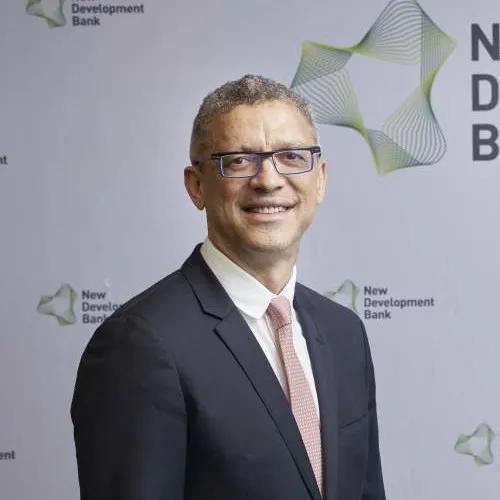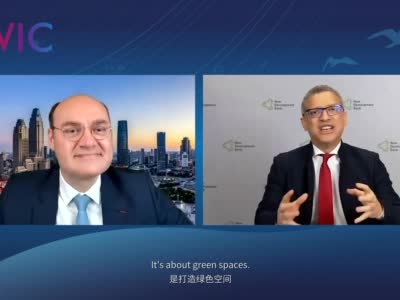
莱斯利·马斯多普 Leslie Maasdorp
莱斯利·马斯多普,现任金砖国家新开发银行副行长兼首席财务官。他在私营和公共部门担任高层领导职务超过25年。此前,他曾任美银美林南非分行董事总经理和行长。2002年,他成为首位被任命为高盛国际顾问的非洲人。
Leslie Maasdorp, Vice President and Chief Financial Officer of the New Development Bank, has over 25 years’ experience in senior leadership roles in both private and public sectors。 Most recently, he served as a Managing Director and President of Bank of America Merrill Lynch for Southern Africa。 In 2002, he was the first African to be appointed as International Advisor to Goldman Sachs International。
高大伟:莱斯利,你很了解天津,因为你来过天津很多次了。你也知道对天津来说,世界智能大会是一个非常重要的时刻。在这个大会上,我们会讨论很多关于智慧城市的话题。我想问问你,莱斯利,你怎么看智慧城市这个概念中的绿色维度?
莱斯利:非常感谢你的邀请,大伟。你知道智慧城市的框架和概念在过去几年里不断演变。在所有大国中,包括中国,政策制定者和企业都十分关注智慧城市的构建。
对于我所任职的金砖国家新开发银行来说,我们认为智慧城市是可持续发展的城市,更是绿色的城市。从智慧城市的设计特色来看,其本质是提升城市的空气质量,消除城市中的过度污染。这些污染来源于车辆尾气、工业排放、离城市近的燃煤发电站。金砖银行会深度参与其中,帮助中国、巴西、俄罗斯、印度和南非建设智慧、绿色、更宜居的城市。因为归根结底,智慧城市关乎人们的生活质量,使城市规划更加以人为本,而不仅仅与技术有关。
通常当人们想到智慧城市时,首先想到的是信息、通讯、电信基建。对我们来说,智慧城市是以人为本的发展,是打造绿色空间、建设智能电网。随着智慧城市理念的不断发展,最终会在很大程度上依托技术。我们都会拥有个性化的应用软件,为我们设定每天和每周的碳排放足迹,每个人都能为建设更好更宜居的城市做贡献。
大伟,我想强调一个事实,世界上污染最严重的十个城市中有六个在金砖国家其中大部分在印度。所以我们的机构和中国一样,都非常关注智慧城市的建设。
我想说的最后一点是,智慧城市的理念若要获得成功,需要有远见的政策制定者。在中国,在天津、厦门和我去过的很多其他城市,我都见到过高瞻远瞩的决策者。因为只有灵活变通、不断适应,才能在新技术出现时,做到逐步推进落实。
因此,长远的眼光、长期的规划,对一个高效的智慧城市而言至关重要。我认为这正是天津与众不同的地方。
高大伟:莱斯利,非常感谢你告诉我们,当我们思考智慧城市时,当然需要想到科技,但可持续性和治理方式也是我们需要探讨的两个关键议题。刚才你也提到,智慧城市必须是宜居城市。所以我想提第二个问题:你认为什么样的城市是宜居的?生活在怎样的城市里人们会感到幸福?
莱斯利:大伟,你知道城市是全球最大的碳排放源。为了让世界应对气候变化,城市处于这个议程的中心。
大家可能知道,在所有国家中,中国做到了(以下这点)。2020年9月,中国国家主席习近平在联合国大会宣布将力争在2060年前实现“碳中和”;在2030年前,也就是在未来9年中,实现“碳达峰”,这意味着自那一时点起 中国的碳排放将只减不增。
回到你的问题上从城市宜居性角度来看,这意味着什么呢?这意味着城市规划的全部重心都必须转移到更好地规划人们的生活上来,使人们的生活质量得以改善。
宜居城市是绿色的城市。在这样的城市里,孩子们上学可以用智能交通工具,公交车都是电动的。对了,中国拥有世界上90%的电动公交车,所以宜居城市离不开电动车,因为汽车尾气极大加剧了我们正在经历的污染。另外,目前全球50%的电动车销量在中国。所以,建设宜居城市涉及所有这些不同的元素。正如我强调的,最重要的是灵活变通和规划部署的能力,当新技术出现时,我们就采用和适应。
高大伟:非常感谢,莱斯利。我们会密切关注天津世界智能大会的。这是一个非常重要的会议,对天津、对中国、对世界都是如此。因为在智慧城市、认知城市、宜居城市这个领域,我认为世界需要向中国学习。由量向质的转变在“十四五”规划中有很详尽的阐述,这是中国构思设计也必将执行的新发展蓝图。莱斯利,非常感谢你对天津世界智能大会的丰富贡献,谢谢。
莱斯利:谢谢。
David: Leslie, you know Tianjin very well, because you have been several times in Tianjin。 And you know that, again, this is a very important moment for Tianjin with the World Intelligence Congress, a Congress in which we are going to speak a lot about smart cities。 I wanted to ask you, Leslie, how do you see the green dimension in this concept of smart city?
Leslie: Thank you very much for having me, David。 As you know, the smart city framework and concept have been evolving over the last number of years。 In all of the biggest countries, China included, there‘s been a significant focus by policy makers, by business, to contribute towards this effort, to create smart cities。
For us, where I sit at the New Development Bank, we look at smart cities as sustainable cities, but a strong green element。 If you look at the design features of what is a smart city, ultimately, David, it‘s about cleaning up the quality of air, it’s about ridding the cities of the excessive pollution, which comes from vehicle exhaust, which comes from industrial emissions, which comes from coal-fired power stations, which are near the cities, to be very centrally involved as a bank in helping China and helping Brazil and helping Russia, India, South Africa to not only create smart cities, but green and more livable cities, because, ultimately, David, for us, smart cities is about quality of life and making a city‘s urban planning more people-centered。 It is not about technology。
Often when people think smart cities, the first thing they think about is information, communication, telecoms infrastructure。 For us, a smart city is about people-centered development。 It‘s about green spaces。 It’s about smart grids。 Eventually, as the small city concept evolves, David, it will become very much technology-based。 We will all have personalized apps that will set out what is our emission footprint per day, per week, so that we can each contribute to a better, more livable city。
David, I should highlight to you that some of the most polluted cities in the world, six of the top ten most polluted cities in the world are in the BRICS countries。 Most of them are in India。 So, there‘s a significant focus by our institution, and also here in China, as you know, on creating smart cities。
Maybe the last point I‘d like to make is that it is very important for a smart city concept to be successful, to have far-sighted policy makers。 What we have in China, Tianjin, Xiamen, and many other cities that I have visited, I have seen policy makers focused on the long term, because it’s only the agility, the ability to adapt as new technologies coming, you implement in an incremental manner。
So, long-term horizons, long-term planning is central to an effective, smart city。 I think this is where Tianjin will differentiate itself。
David: Thank you very much, Leslie, for telling us that when we think about a smart city, of course, we need to think about technology, but sustainability and governance are also two key themes that one needs to discuss。 But you said also in your presentation that a smart city has to be a livable city。 I wanted to ask you a second question, what in your opinion makes a city livable, a city in which we feel happy to live in?
Leslie: Cities, David, as you know, are the single largest contributors to emissions globally。 In order for the world to deal with climate change, cities are right at the center of that agenda。
As you know, just as a backdrop, in all of our countries, China has, in September 2020, President Xi Jinping at the United Nations General Assembly announced 2060 as the date when China wants to achieve carbon net zero。 And by 2030, which by the way is 9 years from now, China wishes to have peak emissions, which means that from that point onwards, China will only remove more emissions from the atmosphere。
Come to your question, what does that actually mean in terms of the livability of cities? It means that the entire focus of planning has to shift towards organizing people‘s livelihood in such a manner that they can improve their quality of life。
A livable city is about green spaces。 It‘s about a city where children can go to school with smart mobility where buses are electrified。 China, by the way, has 90% of the electric bus fleet in the world。 So, livable cities is about electric vehicles because emissions from cars contribute greatly to the pollution that we are experiencing。 Again, 50 % of all electric vehicle sales in the world today are in China。 So, making a city livable is about all of these different elements。 And what’s important, as I highlighted, is that agility, the ability to plan, move forward, when new technology comes, you adopt and you adapt。
David: Thank you very much, Leslie。 So, we will pay attention to the World Intelligence Congress。 This is a very important event for Tianjin, for China, but I think also for the world。 Because in terms of smart cities, cognitive cities, or livable cities, it seems to me that the world also has to learn from what China is doing and the shift from quantity to quality is very well illustrated in the 14th Five-Year Plan that China has just conceived, designed, and that China will implement。 Thank you very much, Leslie, for your very rich contribution to the World Intelligence Congress。 Thank you。
Leslie: Thank you。

 play
play